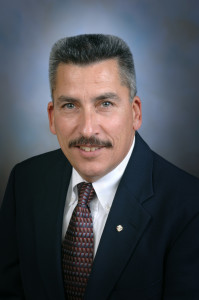
“When the preparation of the next generation of STEM teachers is discussed in education circles, few think of engineering as a pathway to entering the teaching profession,” said Michael De Miranda, professor in Colorado State University’s School of Education and Department of Electrical and Computer Engineering. A new $593,000 grant from the National Science Foundation will allow De Miranda, and his colleague in the Department of Civil and Environmental Engineering, Thomas Siller, to change that.
As part of the grant, De Miranda and Siller will develop pathways for students in each of four engineering departments to enter the teaching profession. Currently only students in the engineering science major can also earn teacher licensure. The researchers plan to add a teacher licensure option for engineering majors in the following departments: Chemical and Biological Engineering, Civil and Environmental Engineering, Electrical and Computer Engineering, and Mechanical Engineering.
Engineers and STEM
De Miranda says engineers are uniquely qualified to excel at teaching STEM subjects (science, technology, engineering, and math). Science and math are often taught as abstract subjects in isolation from each other without reference to applied projects. Engineers, however, learn to apply those concepts through project-based learning. De Miranda calls this learning “connecting the STEM dots” through a process of design, problem solving, experimentation, and optimization for a specific project.
“Engineering students are well-trained in how to get young people to connect the STEM dots and understand the connections between the natural world and the designed world,” said De Miranda. “This will provide another option for preparing highly qualified teachers for our kids in middle and high schools.”
Developing these pathways for engineers to become professional educators will include developing new courses, as well as a system of seamless advising in both the College of Engineering and the School of Education’s teacher licensure program. One of the key goals of the grant is to develop a program that can be replicable for other universities and become a model for the nation.

De Miranda gives the example of one of his engineering student teachers, John Avery, who was in a classroom building a solar oven with high school students. Not only did the students build ovens, but they learned the mathematical equations necessary to measure the amount of energy and power generated by the ovens. Avery designed an experiment in which students measured the ambient temperature of water in a glass container outside the oven, measured the temperature of water in a like glass container placed inside the oven, and then calculated the amount of heat energy captured by the solar collector oven. This incorporation of math, physics, and engineering in one activity is how students learn to connect the STEM dots.
Teacher preparation
Another part of the grant includes working closely with the Center for Educator Preparation in the School of Education to develop new courses to prepare cross-trained STEM teachers. The courses will incorporate this integrated STEM learning, or iSTEM, so that future teachers can learn how subjects can be taught across the STEM disciplines. De Miranda also envisions preparing STEM teachers to work together in teams in schools to co-plan activities and deliver long-term scientific and engineering design problems to engage students.
There is also a research goal for the grant. The researchers are refining iSTEM and iDesign scales that measure learning integration and how effectively kids learn to design and innovate and to connect the dots.
“Making sure we are producing some of the best-qualified teachers for our kids is our responsibility. This grant will help provide more diverse career pathways for college students to become teachers,” said De Miranda. “Engineering students want to solve problems and make a difference in the world, whether it be developing clean water sources, a cleaner-burning cookstove, the best new medical devices, or the most energy-efficient car. Going into middle schools and high schools and preparing kids for the world we live in is another way for engineering students to make the world a better place.”